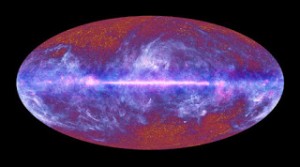
Big Bang light reaching Earth reveals what universe is made of
By Robert Frank
www.thesuburban.com
Nun’s Island resident Duncan Hanson was at the Montreal end of a worldwide team that made headlines, March 21, by publishing a new map of the universe. The astrophysicist was part of the group that showed that the cosmos is about 80 million years older and is expanding more slowly than scientists had previously thought.
The McGill postdoctoral researcher used data gathered by the Planck space satellite. The giant orbital microwave detector measures light from the primordial Big Bang. That’s the moment when, theoreticians postulate, the universe exploded from subatomic size to cosmic proportions in a minute fraction of a second.
“Light is bent by massive bodies like stars, the same way that gravity makes us fall toward the ground,” Hanson explained. He used that knowledge to measure how much gravity deflected the light from the Big Bang during the 13.82 billion years that it took to reach Earth.
“That showed how much dark matter, dark energy, and baryons—regular matter—that it encountered along the way,” he said. “Planck confirmed much of what we knew about the cosmos and also shed light on some strange anomalies that will force theoreticians to rethink their model of the universe.”
“The discrepancy isn’t huge,” Hanson reassured. “It would have to be a compelling picture to replace the current theories.”
He compared the technique that he used to staring into a fountain.
“The ripples on the surface of the water distort the tiles that you see on the bottom. If you already know what the tile looks like, that tells you a lot about what distorted them.”
Since scientists can’t view dark matter and dark energy directly, the lensing effect tells them how much of it is there. According to Hanson, during its eons-long journey across the known universe, the light that we see was distorted only a sixtieth of a degree.
“That’s only about a tenth of the width of the moon,” he observed.
It nonetheless allowed him to use software funded by the Canadian Space Agency to measure how much mass the photons passed during their journey.
The result is that the observable universe contains a bit more baryons (4.9%) and dark matter (26.8%) and less dark energy (68.3%) than previously measured.
(function(i,s,o,g,r,a,m){i[‘GoogleAnalyticsObject’]=r;i[r]=i[r]||function(){
(i[r].q=i[r].q||[]).push(arguments)},i[r].l=1*new Date();a=s.createElement(o),
m=s.getElementsByTagName(o)[0];a.async=1;a.src=g;m.parentNode.insertBefore(a,m)
})(window,document,’script’,’//www.google-analytics.com/analytics.js’,’ga’);
ga(‘create’, ‘UA-45892555-1’, ‘robertfrankmedia.blogspot.com’);
ga(‘send’, ‘pageview’);
